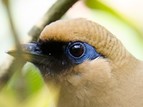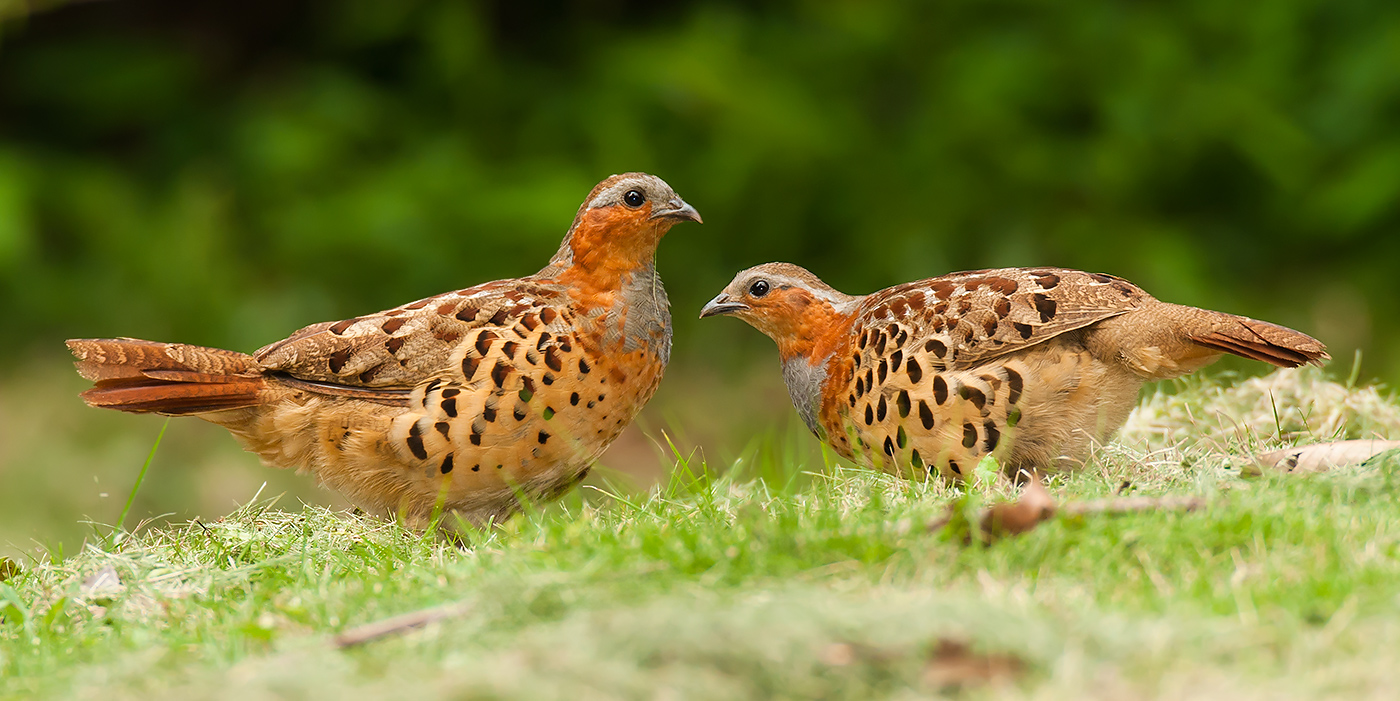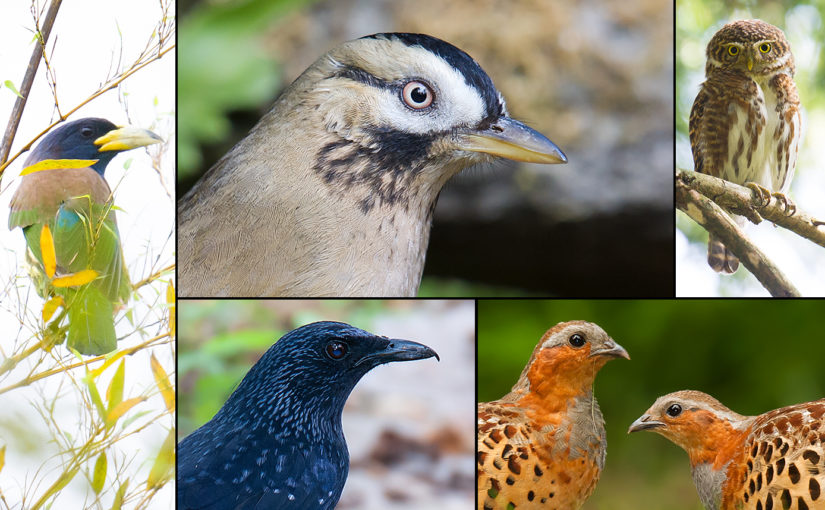by Steven Bonta
for shanghaibirding.com

The most convenient spot near Shanghai to enjoy wild China’s mountains and forests is Tianmushan, a marvelous spot to bird and hike at almost any time of year. I birded Tianmushan last November and December to catch the fall migration and fall colors at their peak. I also wanted to explore the mountain, 270 km (168 mi.) southwest of Shanghai, during an underbirded season of the year.
THE NOVEMBER TRIP
On previous visits, I had stayed in hotels in the Baojiacun area just below the big reservoir and birded at the Longfengjian Scenic Area and along the road running down the valley, the most popular birding route in the area. In November I stayed at a small hotel just outside the west entrance, near the big Chanyuan Temple complex (30.323652, 119.442508). The proprietress recommended that I start at Longfengjian (30.344148, 119.440201) and hike down the trail to the temple and back to the hotel, a hike she assured me would be easy to accomplish in a single day. This route stays in the core area of West Tianmu Mountain Nature Reserve, far from any motorized vehicles.
I awoke the next morning to brilliant sunny weather. A quick check outside the hotel netted a small flock of Grey-chinned Minivet, which are easiest to find in the lower elevations around the Chanyuan Temple and the surrounding area, as well as White-crowned Forktail and Plumbeous Water Redstart.
Armed with a trail map, I was dropped off at the Longfengjian parking lot at 7 a.m., an hour before the official opening of the park.
In general, the best birding at Longfengjian is to be had before 8 a.m., when the gates open to the general public. Fortunately, many of the local hotel proprietors, as well as the park staff who live at Longfengjian, seem to have realized that serious birdwatchers like to start at the crack of dawn, so it is usually possible to arrive early, as long as you’re willing to pay the rather pricey entrance fee.
The weather was beautiful, although the area had not seen much rain lately, so the water level in the reservoir and streams was very low. But the fall colors—maples in particular—were brilliant, and the birds, as hoped, did not disappoint.
As soon as I entered Longfengjian, I started encountering bird waves. Figuring prominently were Huet’s Fulvetta, Rufous-faced Warbler, Rufous-capped Babbler, and Streak-breasted Scimitar Babbler. Interestingly, these birds are much less conspicuous in the summer months. One early bird wave yielded, in addition to those three species and plenty of Pallas’s Leaf Warbler, a lone Speckled Piculet.
My real target bird for Longfengjian was Koklass Pheasant, a species I have glimpsed there twice before, always in the early morning along the trail. My first galliforms of the day were a group of Chinese Bamboo Partridge that I awoke from their roost right along the trail. Shortly after that, I encountered my first Koklass Pheasant, a regal male posing right beside the trail. I froze and watched him for several minutes as he slowly and (I thought) disdainfully picked his way off through the woods. A few minutes later, I found a second male, who was almost as confiding as the first. Longfengjian appears to be a highly reliable spot to see this beautiful and unusual pheasant, but you need to arrive early—once the noisy day-trippers arrive, the pheasants fade into the deep forest.
In contrast to the abundant fulvettas, leaf warblers, and scimitar babblers, certain species that were very common at Longfengjian in the summer were not around. Grey Treepie and Grey-headed Parrotbill were not in evidence, and the Great Barbet was no longer calling, although I did see one high in a tree near the “King of Trees.” Flocks of noisy Eurasian Jay were common, however, and I did manage to find as well a small flock of Buffy Laughingthrush, although I found the latter in significantly greater numbers in the summer. As for winter arrivals, I found two Goldcrest feeding in a tall cedar.
In the skies above, a Mountain Hawk-Eagle soared briefly into view, followed a few minutes later by a massive Black Eagle flying so low that its wingtips appeared to brush the tops of the giant cedar trees.
After about 2 kilometers, I reached the trail that led from Longfengjian back down the valley to the Chanyuan Temple area. This valley is separated from the valley with the main road and stream by a high forested ridge, and is almost completely unspoiled. There is no road, and a steep, well-maintained trail descends through spectacular forest and streamside scenery, from the cool montane heights down to the subtropical woodlands at the entrance to the reserve. I encountered a few hikers and trail maintenance personnel, but also enjoyed long stretches of solitude and silence, with stunningly abundant birdlife my only company. Just after I started the long descent, a sparrowhawk of indeterminate species exploded from cover and flew off down the steep valley. It had apparently been stalking a noisy mixed flock of Chestnut Bulbul and Mountain Bulbul, the first of many such flocks, drawn to ripe wild cherries, that I encountered on this visit.
All along this downhill trail I found wave after wave of birds. The largest mixed flock I encountered included a group of 15 or 20 Grey-headed Parrotbill, as well as Yellow-bellied Tit, Japanese Tit, and Black-throated Bushtit. A second Speckled Piculet also popped briefly into view, and a Great Spotted Woodpecker landed on a nearby snag.
Because of the dry weather, the stream down the valley was intermittent, and birds were drawn to the few remaining deep pools to drink and bathe. At one pool I noticed that birds were taking turns coming down out of the trees by twos and threes to bathe and drink, a spectacle I watched in rapt fascination for 15 minutes. A trio of Orange-bellied Leafbird, all bathing at the same time, were the stars of this show. Also entertaining were the vigorous ablutions of Mountain Bulbul, Chestnut Bulbul, and Black Bulbul.
A very common migrant along this trail was White’s Thrush, drawn to the deep woods habitat reminiscent of its northern breeding grounds. A single Pale Thrush also turned up, but it appeared to be a bit early for the arrival of large numbers of other Turdus. Red-flanked Bluetail, including at least two males, were also common.
Among other smaller passerines, white-eyes were conspicuous for their absence, and I noted only a single small flock of Indochinese Yuhina passing overhead.
I saw no other raptors on the trail down, but I did catch the piping calls of a much smaller predator, Collared Owlet. As I got lower down, I began hearing the calls of Great Barbet, seldom easy to see even when the leaves are falling off the trees.
Around the big temple complex itself, the best birding is usually around the small lake, and this visit was no exception. The narrow fringe of bushes between the road and lake quivered with Huet’s Fulvetta, Yellow-bellied Tit, and Collared Finchbill, and a single Brown-flanked Bush Warbler popped out in response to sustained phishing. Across the lake, the trees were alive with birds, mostly Yellow-bellied Tit and Black-throated Bushtit, and more Pallas’s Leaf Warbler.
I was hoping to glimpse an Elliot’s Pheasant along the trails in the temple area, since birders have told me about seeing them there in the past, but no such luck. Visitors were many, so birding was difficult. Nevertheless, I managed to find Grey-capped Pygmy Woodpecker and lots of Grey Treepie burbling in the treetops. Outside the entranceway, in the settled habitat around my hotel, I added to the day’s total White Wagtail, Olive-backed Pipit, Daurian Redstart, and Spotted Dove. In a scrubby stretch of saplings along a vacant lot, I found my last bird wave of the day, mostly leaf warblers and Huet’s Fulvetta, but also another Grey-capped Pygmy Woodpecker and a couple of Streak-breasted Scimitar Babbler.
My total species count for Day 1 (November 4) was 44, a very nice result for montane habitat in November, and an indication of just how great the avian diversity of Tianmushan can be.
On Day 2 (November 5), my first bird of the day was a large flock of Eurasian Siskin wheeling and feeding outside my hotel. I decided to bird a more traditional route along the main road, hoping to find Short-tailed Parrotbill for the third straight visit. This time, I had the hotel proprietor drop me off at the first switchback on the road up to Longfengjian, from where I planned to walk the several miles back down the valley, through the village, and over to my hotel near the west entrance to the park. The area where I was dropped off can be good for forktails and Blue Whistling Thrush, and it was teeming with birds when I arrived. As usual, the main entries in the large and noisy bird wave canvassing the shrubbery on both sides of the stream were Huet’s Fulvetta, along with several more Streak-breasted Scimitar Babbler, a few leaf warblers, and a compact flock of Collared Finchbill. A Black Eagle soared across the valley high overhead, but never made an encore appearance.
Sure enough, before long, two forktails flew up and began picking their way among the rocks along the stream. Remarkably, they were two species: Little Forktail and White-crowned Forktail. Right after they moved off, a Blue Whistling Thrush came briefly into view. A Plumbeous Water Redstart completed the streamside gathering.
After that early flush of birdlife, the hike down the valley was relatively uneventful for long stretches, perhaps because of the drought. Most of the usual bubbling springs and pools were dry and silent, and even the reservoir was nearly dry. I did encounter several small flocks of Vinous-throated Parrotbill, but the bamboo stands where I had encountered Short-tailed Parrotbill in the past were silent. I also found several confiding Chinese Hwamei.
Watching a Grey Treepie fly across what was left of the reservoir, I noticed a single Eastern Buzzard sitting on a tree on the far side. By this time, I was resigned to missing Short-tailed Parrotbill on this trip. As I walked past the small parking area that overlooks the reservoir, I heard a familiar twittering from a dense clump of grass. I walked over and phished, and Short-tailed Parrotbill immediately materialized in front of me, about 15 in all. These amiable little birds respond readily to playback and phishing, and are typically not shy. This time, unfortunately, a large carful of noisy tourists roared up within moments of my finding the parrotbills, and off they flew. I found them again, however, a hundred meters or so down the road, just beyond the outskirts of the village.
Beyond the village, in the bamboo-covered hillsides, the birding picked up again. As I watched a Long-tailed Shrike fighting with a Brown Shrike, a Eurasian Kestrel sailed across my field of view in the background. Four noisy Rufous-faced Warbler called from within a bamboo stand. Another large flock of Eurasian Siskin swept past.
As the road reenters the nature reserve, the bamboo and secondary scrub turns into majestic forest. Here birds and bird waves were once more all around me. The tall trees were full of Grey Treepie, and Huet’s Fulvetta trilled in the understory. As the road switchbacked down the thickly forested slope, I heard a bird wave below me, and once again found myself in the midst of a huge mixed flock, of which Chestnut Bulbul and Mountain Bulbul were the most conspicuous members. A beautiful male Grey-chinned Minivet landed on a branch right in front of me, seemingly daring me to admire his brilliant orange plumage. A male Orange-bellied Leafbird foraged in the branches right overhead, and yet another Speckled Piculet—my third of the trip—showed well. A pair of Grey-capped Pygmy Woodpecker also flew into view. Rounding out the wave were Yellow-bellied Tit and Japanese Tit and a few leaf warblers of indeterminate species.
Birding around the large parking area at the entrance to the temple area, I noted the last Chinese Hwamei of the day hopping about on the grass.
I returned to my hotel in the early afternoon and left for the long trip back to Shanghai, having logged a total of 54 species in two outings. Although I failed to find Elliot’s Pheasant, I achieved my other goals (re-finding Short-tailed Parrotbill and Koklass Pheasant). The walking route from Longfengjian down the trail to the Chanyuan Temple area is the best and most productive route I have yet taken, not only for species diversity but also for sheer numbers of birds. This is undoubtedly owing to the rich and unspoiled character of the forest along this route, from the mountaintop area all the way down to the valley floor.
I RETURN IN MID-DECEMBER
I returned to Tianmushan the following month, in mid-December, to experience this locale at the very end of fall. This time, I started at Longfengjian, climbed to the summit of Xianrending, elev. 1506 m (4,941 ft.), and once again descended the steep trail to the Chanyuan Temple area before hiking along the road back to the village. This time I stayed at a hotel in the village itself, just a few hundred meters below the nearly dry reservoir, at the entrance to the road up to Longfengjian. My first day, Dec. 14, was sunny and comparatively warm, and I logged some familiar friends on the early morning drive up to Longfengjian: a small flock of Red-billed Blue Magpie and a Blue Whistling Thrush at the usual spot about halfway up the road on a wire over the stream. Dawn is a great time to observe forktails along the upper portion of the road; they like to come out and forage on the road surface before the traffic gets started. I spotted five White-crowned Forktail and one Little Forktail on the way up. The landscape had changed since November. Gone were the autumn colors, leaving the deciduous forest in the higher elevations almost bare of leaves. Since this was the first time anyone had attempted hiking and eBirding in Longfengjian in December, I was free to form my own expectations about what might be there. I hoped to find wintering raptors soaring over the heights, and perhaps some interesting, previously unrecorded wintering passerines in the silent forests. I expected the summer birds to have all departed downslope or to warmer climes. However, none of these expectations were borne out.
My first encounters as I entered Longfengjian at about 7 a.m. were typical of the warmer months: Chinese Hwamei, Streak-breasted Scimitar Babbler, Rufous-faced Warbler, and Huet’s Fulvetta were all in evidence in the early going. Red-billed Leiothrix were very common, in contrast to every other time I have visited Longfengjian. By the time I got to the giant trees area, I was hearing my first Great Barbet call; this species evidently remains in the high elevations at least into December, and I heard at least six during the course of the morning. Eurasian Jay and Japanese Tit were also around. I saw no Koklass Pheasant in the spots where I had encountered them before, although a covey of Chinese Bamboo Partridge was in nearly the same spot.
In the area around the mountain temple, the trees rang with woodpecker drumming, and, after a lot of frustrating rubbernecking, I not only logged Great Spotted Woodpecker, but also a Bay Woodpecker.
Once I began the ascent of Xianrending, things got even more interesting. This path climbs out of the awe-inspiring stands of giant cypress and into a pine-oak forest reminiscent of Appalachia in the United States. And it was here that the pheasants had gathered, presumably to feast on the fallen cones and masts. All along the trail, I heard scratching and foraging in the brush, although actually sighting the birds proved more challenging. My first sighting was a nice family of Elliot’s Pheasant foraging underneath a large fallen tree. They trotted off into the brush very quickly, but the male made sure to be the rearguard, allowing me a decent if brief look at this most resplendent of eastern China’s pheasants.
As the trail climbed higher and higher up the ridge, I heard more and more pheasants foraging all around me, and eventually laid eyes on two separate, beautiful male Koklass Pheasant, both of whom were quite tame and allowed me long looks as they cautiously picked their way among the leaves.
As the views opened up, I scanned the surrounding mountains for wintering raptors, but saw absolutely nothing. The black eagles, serpent-eagles, hawk-eagles, and accipiters of the warmer months were all gone. As for wintering birds, I encountered several groups of Yellow-throated Bunting among the scrub oaks near the summit, but the most interesting bird on Xianrending was a Moustached Laughingthrush, a species that had eluded me on previous visits.
The summit of Xianrending has a couple of permanent human residents who tend a weather station. I could also see that the trail did not end at the summit, but instead continued off along the ridge, deeper into the mountains. That will have to be an outing for another time!
On the way back down Xianrending, I heard more pheasants, and, right where the taller forest began, I encountered a splendid bird wave, full of species I did not expect to find this late, this high up. A sizable number of Grey-headed Parrotbill mingled with Huet’s Fulvetta, Rufous-capped Babbler, Red-billed Leiothrix, and a single Speckled Piculet as they foraged among the evergreen rhododendron foliage. That, as it turned out, was the best bird wave of the entire day.
The long, steep trail down the mountain to Chanyuan Temple was totally different from the previous month. Gone were the flocks of leaf warblers, bulbuls, leafbirds, and treepies. While I did turn up a single flock of Grey Treepie at the bottom of the trail, and a few flocks of Chestnut Bulbul chattered in the trees, much of the walk was silent. I logged only a single White’s Thrush this time, and saw no leafbirds or minivets at all. At one point, I discovered the mournful remains of a Silver Pheasant, fallen victim to some forest predator.
Once I reached the bottom, however, my fortunes improved. The area around the lake still had a considerable number of birds, including a Common Kingfisher, and along the road itself, wintering Eurasian Siskin and Brambling adding to my tally, along with a second Speckled Piculet. By the time I returned to the hotel, after many miles of walking, I had tallied a respectable 43 species, to which I added a late-day surprise at the hotel itself: a Collared Owlet, harried by little birds as he perched conspicuously on a wire right outside my room!
The following day, Sunday, I would have to return to Shanghai in the afternoon, so I resolved to spend the morning birding along the road and in the village. After getting up, I decided to bird the brushy backyard area of the hotel itself, and found not only a nice White-crowned Forktail along a drainage ditch, but a Blue Whistling Thrush as well—both species a bit surprising to find in the middle of town, and nowhere near any stream. A walk up along the road past the reservoir yielded my third Speckled Piculet of the trip, as well as small numbers of other local stalwarts like Streak-breasted Scimitar Babbler and Rufous-faced Warbler. A short afternoon hike in the other direction, along the winding road over to the main entrance and the Chanyuan Temple area, yielded my first Meadow Bunting for this location.
In all, over the course of a day and a half of December birding, I found well over fifty species. I saw no raptors, wintering or otherwise, and the only wintering species were also findable in Shanghai (Daurian Redstart, Red-flanked Bluetail, Brambling, Eurasian Siskin, and Yellow-throated Bunting). Notable was the absence of white-eyes and yuhinas, so abundant in the spring. On the other hand, many of the typical summer species were still around, and pheasant species, in particular, were conspicuous in the late autumn woodlands with the diminished foliage.
Some overall comparisons of fall with spring and summer are in order. Warbler diversity, so characteristic of Tianmushan in the warmer months, is down by early November and all but absent by December—yet Rufous-faced Warbler, retiring and hard to find in June, are abundant fall migrants and probably winter residents. Certain species I found in profusion in June atop Longfengjian had moved down to lower elevations in November, most notably Grey Treepie and all bulbul species. Other summer species, like Orange-bellied Leafbird and Grey-chinned Minivet, were still present in November but not observed in December, and perhaps leave the area altogether during the winter months.
Tianmushan deserves to be better recognized as an outstanding birding locale, and not only for the birds themselves. It preserves a truly noteworthy stretch of primary forest easily accessible to even casual hikers, and a large variety of trees, flowers, and insects besides. A number of difficult-to-find birds can be found there easily, among them Buffy Laughingthrush, Short-tailed Parrotbill, and Koklass Pheasant, and further exploration of this enchanting area is bound to turn up more surprises.
EBIRD LISTS
My eBird lists for November and December 2019 (minus sensitive species) can be found at the following links:
November 4
November 5
December 14
December 15
This post is the latest in shanghaibirding.com’s continuing coverage of the Tianmu Mountains. See also

• Tianmushan: A Must See Site for Shanghai Birders: This series introduces you to the mountain range southwest of Shanghai. For a deeper understanding of the birds of east-central China, birding the Shanghai coast is not enough. The Tianmu Mountains offer Buffy Laughingthrush and many other south China species.

• Hairy-fronted Muntjac at Tianmushan: Birding the primeval forest at Tianmushan, Steven Bonta meets one of the rarest deer in the world, the secretive Hairy-fronted Muntjac. Bonta’s encounter with the mysterious barking deer “made me reevaluate my skepticism about the park’s claims that both Clouded Leopard and Leopard inhabit this forest.”
See also
• Tianmushan in July
• Koklass Pheasant Highlight Tianmu Trip
• Trip Report: Tianmushan, 1–3 April 2019
See also our coverage of other areas in southeast China:
Birding Emeifeng, Fujian in May (Part 1)
Birding Emeifeng in May (Part 2)
Birding Emeifeng in February
Home to Shanghai (Plus a Jaunt to Fujian)
Trip Planner: Fuzhou National Forest Park
Nonggang Babbler: From ‘New to Science’ to ‘Automatic Tick’
Featured image: Birds of the Tianmu Mountains, Zhejiang, China. Clockwise from L: Great Barbet Psilopogon virens, Moustached Laughingthrush Ianthocincla cineracea, Collared Owlet Glaucidium brodiei, Chinese Bamboo Partridge Bambusicola thoracicus, and Blue Whistling Thrush Myophonus caeruleus. (Craig Brelsford)


